As the school year ends, it’s time to encourage students to include frequent visits to their local libraries throughout the summer (and perhaps sign up for summer reading programs). In this week’s column, we review some sweet and savory reads with summery themes as well as several informational books that will get readers of all ages involved in new activities.
Ages 4–8
Hello Summer! (Hello Seasons!). Shelley Rotner. Holiday House.
 What do children do in the summer? They go barefoot, drink lemonade, play in the park, go swsimming, and more! Shelley Rotner’s simple but descriptive text and vibrant color photographs present a diverse group of kids doing all kinds of fun things as the days get longer and warmer following spring and then shorter and cooler with the approach of autumn. Hello Summer! completes author–photographer Rotner’s series celebrating the seasons of the year.
What do children do in the summer? They go barefoot, drink lemonade, play in the park, go swsimming, and more! Shelley Rotner’s simple but descriptive text and vibrant color photographs present a diverse group of kids doing all kinds of fun things as the days get longer and warmer following spring and then shorter and cooler with the approach of autumn. Hello Summer! completes author–photographer Rotner’s series celebrating the seasons of the year.
—JS
Hazy Bloom and the Mystery Next Door (Hazy Bloom #3). Jennifer Hamburg. Ill. Jenn Harney. 2019. Farrar, Straus and Giroux/Macmillan.
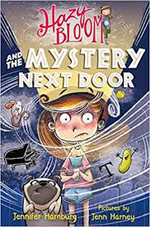 Summer is finally here, and Hazy Bloom is “for real live” ready for the fun to commence. All her friends, however, have summer camp plans, so Hazy is on her own in making vacation exciting—and her “tomorrow power,” strange visions that foreshadow something that will happen the next day, will play a big part. The problem with this superpower, however, is that sometimes she can’t quite predict how a particular vision will actually play out and, in this case, it leads to hilarious missteps and a mystery involving the empty house next door that’s not quite as scary as Hazy thinks it is.
Summer is finally here, and Hazy Bloom is “for real live” ready for the fun to commence. All her friends, however, have summer camp plans, so Hazy is on her own in making vacation exciting—and her “tomorrow power,” strange visions that foreshadow something that will happen the next day, will play a big part. The problem with this superpower, however, is that sometimes she can’t quite predict how a particular vision will actually play out and, in this case, it leads to hilarious missteps and a mystery involving the empty house next door that’s not quite as scary as Hazy thinks it is.
—JS
The Nature Girls. Aki. 2019. Godwin/Henry Holt/Macmillan.
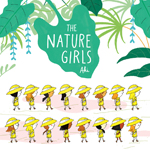 “We’re Nature Girls! We must explore. / We pack our bags, we’re out the door. / . . . and off we go!” The 16 adventurous and always-smiling Nature Girls take young readers on a trek around the globe as they explore various biomes, beginning with a journey to the sea where they scuba dive and swim with dolphins and fish. Aki’s vibrant cartoon illustrations invite readers to examine each page closely to spot the various animals that inhabit each biome. Back matter includes a two-page spread “Meet the Biomes” providing a definition of the term biome and brief information about the biomes (aquatic, desert, grassland, tundra, forest) featured in the book.
“We’re Nature Girls! We must explore. / We pack our bags, we’re out the door. / . . . and off we go!” The 16 adventurous and always-smiling Nature Girls take young readers on a trek around the globe as they explore various biomes, beginning with a journey to the sea where they scuba dive and swim with dolphins and fish. Aki’s vibrant cartoon illustrations invite readers to examine each page closely to spot the various animals that inhabit each biome. Back matter includes a two-page spread “Meet the Biomes” providing a definition of the term biome and brief information about the biomes (aquatic, desert, grassland, tundra, forest) featured in the book.
—JS
Sea Glass Summer. Michelle Houts. Ill. Bagram Ibatoulline. Candlewick.
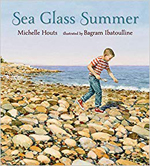 In the summer, Thomas enjoys using a magnifying glass that belonged to his grandfather to explore things that wash up on the beach near his grandmother’s island cottage and begins collecting sea glass with her. When Thomas finds a new piece, he has a dream that night about how the glass wound up in the sea long ago. Returning home at the end of the summer, Thomas drops the magnifying glass on the deck of the ferry and throws the broken pieces overboard. Years later, another child finds a piece of sea glass and dreams about a boy named Thomas. Bagram Ibatoulline’s stunning watercolor paintings show the connection between the past and present with the children’s summer activities at the seaside in full color and their dreams in dramatic, gray-toned double spreads.
In the summer, Thomas enjoys using a magnifying glass that belonged to his grandfather to explore things that wash up on the beach near his grandmother’s island cottage and begins collecting sea glass with her. When Thomas finds a new piece, he has a dream that night about how the glass wound up in the sea long ago. Returning home at the end of the summer, Thomas drops the magnifying glass on the deck of the ferry and throws the broken pieces overboard. Years later, another child finds a piece of sea glass and dreams about a boy named Thomas. Bagram Ibatoulline’s stunning watercolor paintings show the connection between the past and present with the children’s summer activities at the seaside in full color and their dreams in dramatic, gray-toned double spreads.
—JS
Sandy Feet! Whose Feet? Footprints at the Shore. Susan Wood. Ill. Steliyana Doneva. Sleeping Bear.
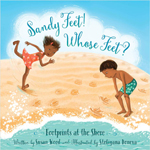 “Wading feet, / sandpiper hops / water curls and sprays. / Crawling feet, / click-clack crab / scuttles on its way.” On a family outing at the beach, two young children investigate a variety of tracks they find in the sand. Told in brief rhyming text, this is a delightful summer story about their joy in exploring footprints at the shore. An appended two-page spread includes notes about being an “ecology detective” and identifying the animals that made the tracks the children discover. Whimsical illustrations in beachy colors add to the warm tone of this story about a fun summer activity.
“Wading feet, / sandpiper hops / water curls and sprays. / Crawling feet, / click-clack crab / scuttles on its way.” On a family outing at the beach, two young children investigate a variety of tracks they find in the sand. Told in brief rhyming text, this is a delightful summer story about their joy in exploring footprints at the shore. An appended two-page spread includes notes about being an “ecology detective” and identifying the animals that made the tracks the children discover. Whimsical illustrations in beachy colors add to the warm tone of this story about a fun summer activity.
—JS
Waiting for Chicken Smith. David Mackintosh. 2019. Candlewick.
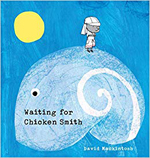 The narrator has just arrived at his family’s cabin and is awaiting the arrival of his friend, Chicken Smith, who spends the summer at the beach with his dad and his dog, Jelly. Ignoring his little sister’s attempts to get him to join her activities, he hangs around Chicken’s vacant cabin and thinks about the adventures they’ll have once he arrives. Realizing that his friend’s cabin looks different this year (readers will notice a Summer Rental sign on the door), he walk down to the beach and, responding to his sister’s “Just hurry up!” cry, follows her up the hill to the lighthouse and sees something he and Chicken have never seen: a whale. David Macintosh’s mixed-media illustrations set the scene for this touching story of a child’s anticipation of renewal of an old friendship and the possibility of making new memories of summer fun with someone else.
The narrator has just arrived at his family’s cabin and is awaiting the arrival of his friend, Chicken Smith, who spends the summer at the beach with his dad and his dog, Jelly. Ignoring his little sister’s attempts to get him to join her activities, he hangs around Chicken’s vacant cabin and thinks about the adventures they’ll have once he arrives. Realizing that his friend’s cabin looks different this year (readers will notice a Summer Rental sign on the door), he walk down to the beach and, responding to his sister’s “Just hurry up!” cry, follows her up the hill to the lighthouse and sees something he and Chicken have never seen: a whale. David Macintosh’s mixed-media illustrations set the scene for this touching story of a child’s anticipation of renewal of an old friendship and the possibility of making new memories of summer fun with someone else.
—CA
Ages 9–11
Caterpillar Summer. Gillian McDunn. 2019. Bloomsbury.
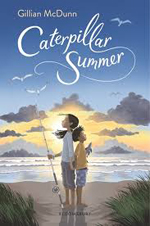 Even though she’s only 11, Cat has always taken charge of her younger brother, Chicken, who has special needs. Their dad died when they were younger, and their mom is a children’s book author who holds down a variety of small teaching jobs to make ends meet. When their summer plans take an unexpected turn, Cat and Chicken find themselves spending three weeks on Gingerbread Island with their maternal grandparents, whom they meet for the first time. Cat and Chicken find island life fun, and they enjoy getting to know their grandparents in this story of family secrets, growing up, and getting along, which ends with Cat and Chicken looking forward to spending the next summer on Gingerbread Island.
Even though she’s only 11, Cat has always taken charge of her younger brother, Chicken, who has special needs. Their dad died when they were younger, and their mom is a children’s book author who holds down a variety of small teaching jobs to make ends meet. When their summer plans take an unexpected turn, Cat and Chicken find themselves spending three weeks on Gingerbread Island with their maternal grandparents, whom they meet for the first time. Cat and Chicken find island life fun, and they enjoy getting to know their grandparents in this story of family secrets, growing up, and getting along, which ends with Cat and Chicken looking forward to spending the next summer on Gingerbread Island.
—JS
Maybe a Mermaid. Josephine Cameron. 2019. Farrar, Straus and Giroux/Macmillan.
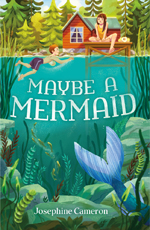 When Anthoni and her mom make a plan, they always “stick to the plan!” That’s one of the many mantras of Beauty & the Bee, the cosmetics company that Anthoni’s mom works for as a salesperson. The plan for this summer is to spend a few weeks at the Showboat Resort on Thunder Lake, where Anthoni’s mom has wonderful memories of summers spent there as a child, and Anthoni has a plan to make this the summer she finds a “true blue” friend. When they arrive, it’s clear that the run-down resort is not the place that her mom fondly recalls, and soon Anthoni finds out why they’re really at the resort. Anthoni learns that having mantras to live by is not quite the same as living in the real world in this novel about finding new friends in unexpected places—and maybe a mermaid.
When Anthoni and her mom make a plan, they always “stick to the plan!” That’s one of the many mantras of Beauty & the Bee, the cosmetics company that Anthoni’s mom works for as a salesperson. The plan for this summer is to spend a few weeks at the Showboat Resort on Thunder Lake, where Anthoni’s mom has wonderful memories of summers spent there as a child, and Anthoni has a plan to make this the summer she finds a “true blue” friend. When they arrive, it’s clear that the run-down resort is not the place that her mom fondly recalls, and soon Anthoni finds out why they’re really at the resort. Anthoni learns that having mantras to live by is not quite the same as living in the real world in this novel about finding new friends in unexpected places—and maybe a mermaid.
—JS
Ages 12–14
The Multiplying Mysteries of Mount Ten. Krista Van Dolzer. 2019. Bloomsbury.
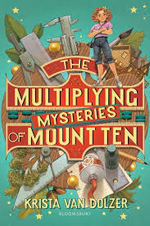 Twelve-year-old artistic Esther’s plans for a fabulous week at Camp Vermeer go awry when her stepfather drives up the wrong mountain during a storm and they have an accident that disables their old truck. Taking refuge at Camp Archimedes, Esther is disheartened to find herself stuck at this remote camp for math geeks until the storm abates and the truck is repaired. She surprises everyone, including herself, when she solves the First Problem challenge set by Director Verity. She’s still anxious to get to the art camp, but when she finds a cryptic note from “Sphinx” about a riddle and warning that if it goes unsolved someone at the camp will be murdered, Esther bans together with some of the campers to find clues Sphinx has hidden around the camp and solve the puzzle logically—and also decrypt a cipher that leads to the arrest of a clever art forger.
Twelve-year-old artistic Esther’s plans for a fabulous week at Camp Vermeer go awry when her stepfather drives up the wrong mountain during a storm and they have an accident that disables their old truck. Taking refuge at Camp Archimedes, Esther is disheartened to find herself stuck at this remote camp for math geeks until the storm abates and the truck is repaired. She surprises everyone, including herself, when she solves the First Problem challenge set by Director Verity. She’s still anxious to get to the art camp, but when she finds a cryptic note from “Sphinx” about a riddle and warning that if it goes unsolved someone at the camp will be murdered, Esther bans together with some of the campers to find clues Sphinx has hidden around the camp and solve the puzzle logically—and also decrypt a cipher that leads to the arrest of a clever art forger.
—CA
Nerd A to Z: Your Reference to Literally Figuratively Everything You’ve Always Wanted to Know. T. J. Resler. 2019. National Geographic.
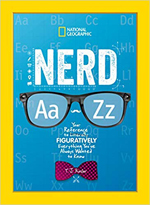 From Artificial Intelligence to Zombies, this information-packed photo-illustrated book could keep readers busy for the whole summer! Defining a nerd as “the kind of kid with smarts, passion, expert knowledge, and the kind of Einstein cool other kids can only dream about,” the National Geographic Kids’ team has put together an alphabet-soup themed book that highlights a variety of topics from science to pop culture. Entries alternate between short pops of information to two-page spreads highlighting high-interest topic and fun “26 Facts About . . .” lists. This is the kind of book that features facts you didn’t even know you wanted to know.
From Artificial Intelligence to Zombies, this information-packed photo-illustrated book could keep readers busy for the whole summer! Defining a nerd as “the kind of kid with smarts, passion, expert knowledge, and the kind of Einstein cool other kids can only dream about,” the National Geographic Kids’ team has put together an alphabet-soup themed book that highlights a variety of topics from science to pop culture. Entries alternate between short pops of information to two-page spreads highlighting high-interest topic and fun “26 Facts About . . .” lists. This is the kind of book that features facts you didn’t even know you wanted to know.
—JS
Ages 15+
Hot Dog Girl. Jennifer Dugan. Putnam/Penguin.
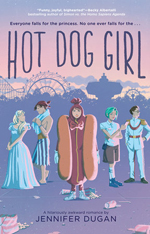 This is 16-year-old Elouise’s second summer dressing up as the Hot Dog at Magic Castle Playland, the local theme park, and while it’s not a glamorous role, somebody’s got to do it. Lou’s friend Seeley also works at the park, and Lou comes up with a scheme where she and Seeley will pretend they are a couple in order to make Nick, her secret crush who stars as a diving pirate in the park’s water show, jealous. This seems like a good plan until she finds herself falling for Seeley and vice versa. A sweet romantic comedy that’s perfect for light summer reading.
This is 16-year-old Elouise’s second summer dressing up as the Hot Dog at Magic Castle Playland, the local theme park, and while it’s not a glamorous role, somebody’s got to do it. Lou’s friend Seeley also works at the park, and Lou comes up with a scheme where she and Seeley will pretend they are a couple in order to make Nick, her secret crush who stars as a diving pirate in the park’s water show, jealous. This seems like a good plan until she finds herself falling for Seeley and vice versa. A sweet romantic comedy that’s perfect for light summer reading.
—JS
All Ages
America’s National Parks. Alexa Ward. Mike Lowery. 2019. Lonely Planet Kids.
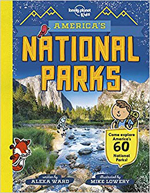 Readers can use this Lonely Planet Kids guide to explore America’s 60 national parks from A to Z—from Acadia National Park to Zion National Park. Front matter includes a map with numbered locations of the parks, an introduction, and a “Safety and Responsibility” chart on visiting the national parks. Each entry features interesting notes on features of the park, a “Park in Numbers” chart, “Things to See” and “Things to Do” insets, and a wealth of stunning color photographs of expansive landscapes and snapshots of park features and wildlife. Back matter includes a glossary and an index. America’s National Parks is perfect for reminiscing about past park visits or daydreaming about adventurous vacation trips to make in the future as well as for armchair traveling across the country.
Readers can use this Lonely Planet Kids guide to explore America’s 60 national parks from A to Z—from Acadia National Park to Zion National Park. Front matter includes a map with numbered locations of the parks, an introduction, and a “Safety and Responsibility” chart on visiting the national parks. Each entry features interesting notes on features of the park, a “Park in Numbers” chart, “Things to See” and “Things to Do” insets, and a wealth of stunning color photographs of expansive landscapes and snapshots of park features and wildlife. Back matter includes a glossary and an index. America’s National Parks is perfect for reminiscing about past park visits or daydreaming about adventurous vacation trips to make in the future as well as for armchair traveling across the country.
—CA
The Dictionary of Difficult Words. Jane Solomon. Ill. Louise Lockhart. 2019. Frances Lincoln.
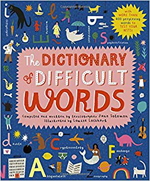 In an introduction to this illustrated collection of more than 400 words that are difficult to pronounce, hard to spell, and have obscure meanings, lexicographer Jane Solomon suggests 10 different ways to use the book such as reading it straight through from A to Z or reading a word aloud and having someone guess the meaning. Each entry includes a pronunciation of the word, its parts of speech classification, and an easy-to-understand definition. Back matter includes information on different types of dictionaries, a question about the reader’s favorite newly learned difficult words (mine is spaghettification), a note on the usage of the word they,and an answer to the question “What makes a word real?” about the creation of new words and how they make it into dictionaries.
In an introduction to this illustrated collection of more than 400 words that are difficult to pronounce, hard to spell, and have obscure meanings, lexicographer Jane Solomon suggests 10 different ways to use the book such as reading it straight through from A to Z or reading a word aloud and having someone guess the meaning. Each entry includes a pronunciation of the word, its parts of speech classification, and an easy-to-understand definition. Back matter includes information on different types of dictionaries, a question about the reader’s favorite newly learned difficult words (mine is spaghettification), a note on the usage of the word they,and an answer to the question “What makes a word real?” about the creation of new words and how they make it into dictionaries.
—CA
Jennifer W. Shettel is a professor at Millersville University of Pennsylvania where she teaches undergraduate and graduate courses in literacy for preservice and practicing teachers. Prior to joining the faculty at Millersville, she spent 16 years as an elementary classroom teacher and reading specialist in the public schools. Carolyn Angus is former director of the George G. Stone Center for Children's Books, Claremont Graduate University, in Claremont, California.
These reviews are submitted by members of the International Literacy Association's Children's Literature and Reading Special Interest Group (CL/R SIG) and are published weekly on Literacy Daily.